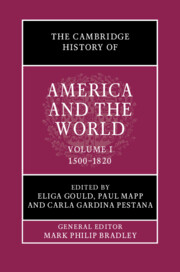Book contents
- The Cambridge History of America and the World
- The Cambridge History of America and the World
- The Cambridge History of America and the World
- Copyright page
- Contents
- Figures
- Maps
- Contributors to Volume I
- General Introduction: What is America and the World?
- Introduction: What Does America and the World “Mean” before 1825?
- Part I Geographies
- Part II People
- Part III Empires
- Part IV Circulation/Connections
- Part V Institutions
- 17 Slavery, Captivity, and the Slave Trade in Colonial North America’s Global Connections
- 18 A Maritime World
- 19 Antislavery in America, 1760–1820: Comparisons, Contours, Contexts
- 20 Women, Gender, Families, and States
- 21 Empires and the Boundaries of Religion
- Part VI Revolutions
- Index
20 - Women, Gender, Families, and States
from Part V - Institutions
Published online by Cambridge University Press: 12 November 2021
- The Cambridge History of America and the World
- The Cambridge History of America and the World
- The Cambridge History of America and the World
- Copyright page
- Contents
- Figures
- Maps
- Contributors to Volume I
- General Introduction: What is America and the World?
- Introduction: What Does America and the World “Mean” before 1825?
- Part I Geographies
- Part II People
- Part III Empires
- Part IV Circulation/Connections
- Part V Institutions
- 17 Slavery, Captivity, and the Slave Trade in Colonial North America’s Global Connections
- 18 A Maritime World
- 19 Antislavery in America, 1760–1820: Comparisons, Contours, Contexts
- 20 Women, Gender, Families, and States
- 21 Empires and the Boundaries of Religion
- Part VI Revolutions
- Index
Summary
Many professors find when they teach the first half of the survey of women’s history in early North America and the United States, that Pocahontas is one of the few women whom students can mention by name at the beginning of the semester. They may know that she was a Native woman who was the daughter of a powerful leader in what the English called Virginia and that “Pocahontas” was her nickname. Some may also know that her given name was Matoaka. If they have not been overly influenced by the Disney film, they may also be aware that she was still a girl when she first encountered the English, and that she married John Rolfe, not John Smith. Depending on students’ educational background and personal history, they initially tend to interpret her marriage to an English man, conversion to Christianity, and adoption of an English name in one of two ways. Either they see that series of events as an example of European violence against Indigenous cultures, or they have an ingrained sense that she willingly joined a “superior” culture and society.
- Type
- Chapter
- Information
- The Cambridge History of America and the World , pp. 442 - 461Publisher: Cambridge University PressPrint publication year: 2022

